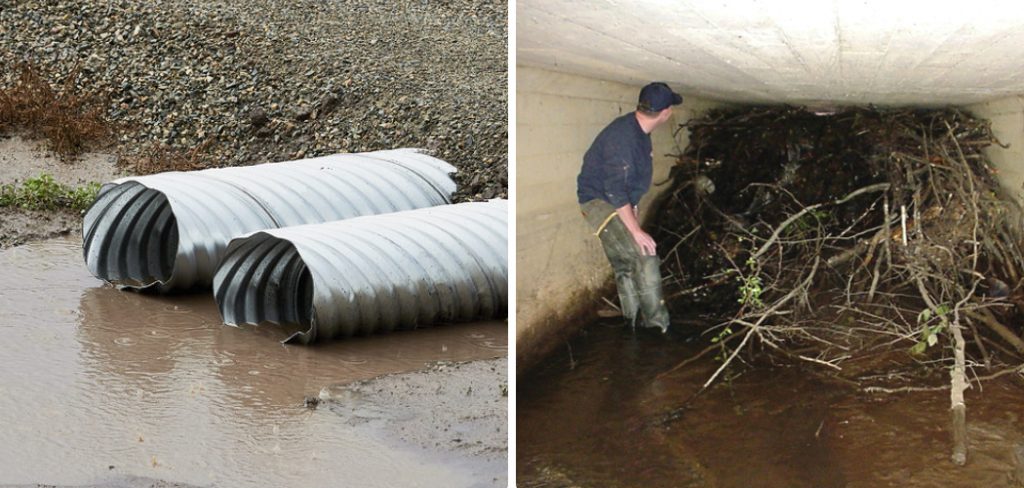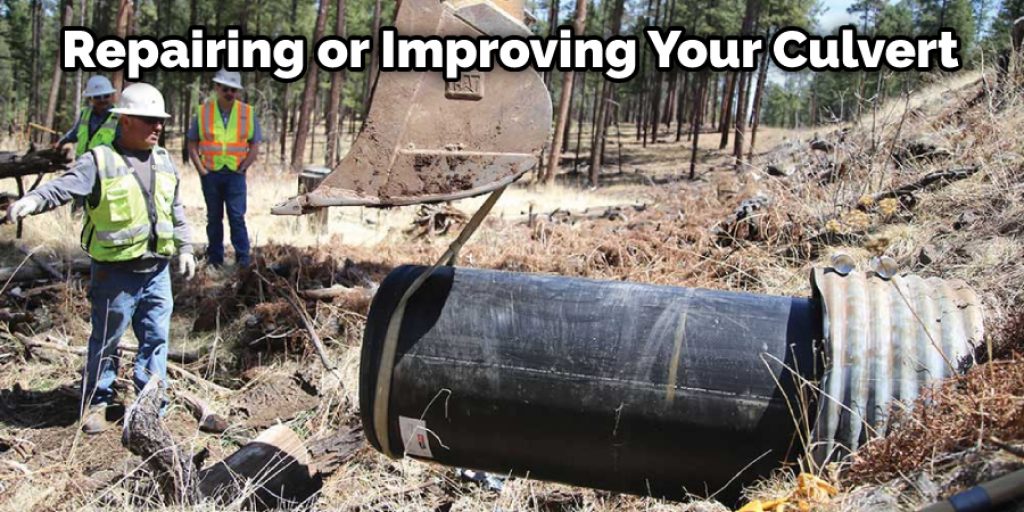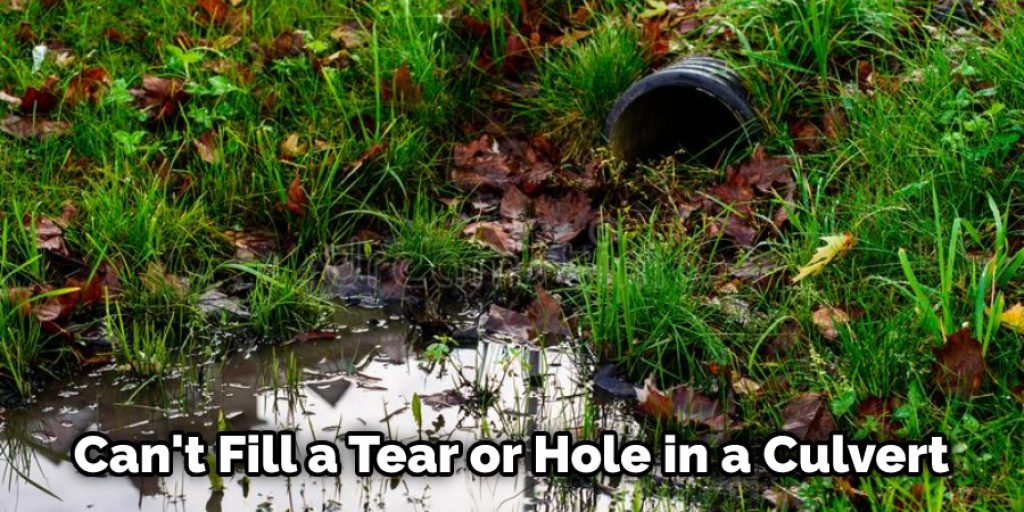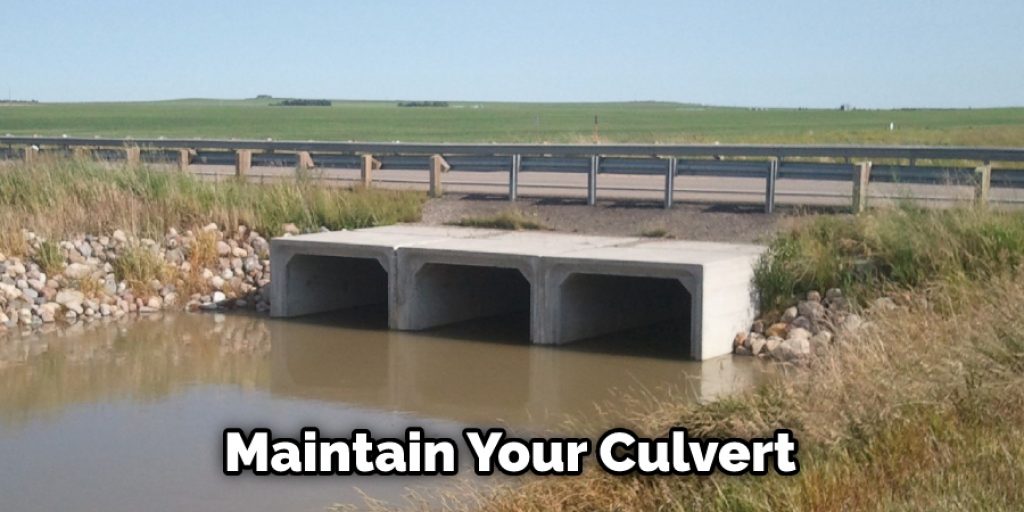Culverts are an important part of any roadway, as they allow water to flow beneath the road while protecting the underlying Infrastructure. However, when a culvert is crushed, it can cause a lot of damage to the surrounding area and be difficult to fix. In this blog post, we will discuss some steps on how to fix a crushed culvert.
If you’ve ever driven down a country road and seen a large metal pipe sticking up out of the ground, then you’ve seen a culvert. Culverts are used to divert water away from roads and bridges, and when they’re working correctly, they’re pretty invisible. Read on to know more!

Summary: This guide offers step-by-step instructions on how to fix a crushed culvert. Options include replacing a smaller culvert, lining a culvert, cleaning a culvert and re-leveling a culvert.
Alternatively, one could replace the culvert entirely or opt for nesting and mounting. Other solutions involve using a plow to dump dirt and level the damage, then lining it and creating a plug. Following these steps should help repair the crushed culvert.
12 Effective Ways on How to Fix a Crushed Culvert
1. Replacing a Smaller Culvert
If the culvert is simply crushed and you can see enough of it to visualize what it’s supposed to look like, you may be able to replace it with a smaller culvert. Although this will increase your initial expenses due to the cost of the material, using a smaller culvert will decrease future costs due to increased efficiency and decreased maintenance.
2. Lining a Culvert
If the culvert is only partially damaged, you may be able to fix it by lining it with rocks or gravel. However, this will not work as well if the culvert is very damaged.
3. Cleaning a Culvert
If there is no damage to the surrounding area, cleaning out a culvert may improve its function and decrease future costs. However, this option should only be chosen if you can repair any leaks or holes after the cleaning is complete.
4. Re-leveling a Culvert
If you level out the surrounding area to match the alignment of the culvert, this may allow for continued functionality at reduced costs associated with future repairs. In addition, this option will require the least amount of work to maintain in the future.
5. Replacing the Culvert Entirely
If no other options are available for repairing or improving your culvert, you may want to consider replacing it entirely. Generally, this option will provide the most long-term benefits and is preferable to older, outdated designs that can malfunction easily.

6. Nesting
Culverts can be stacked on top of each other when they are close together. This is often done in non-public areas, such as parks and hiking trails, where aesthetics aren’t much concern. Although this option will not help with the functionality of the culvert, it does reduce future costs associated with repairing or replacing it.
7. Mounting
If your culvert is made of a strong enough material, it may be possible to use bolts or clamps to mount the oversize product above ground. This option can reduce future costs associated with repairing or replacing your culvert but should only be considered if you are certain that the bolts, clamps, and mounting material will not be damaged or destroyed when the product is under stress (such as water flow in the rain).
8. Using a Plow
Using a plow to push material back around your culvert can sometimes level out dips and bumps created by traffic above it if you have the equipment available. This may not be the most efficient method, but it has been known to work in a pinch.
9. Dumping Dirt
One of the simplest ways to fix culverts is simply bringing in more dirt and dumping it around your structure. This is often an inexpensive way to do things, though you’ll need a truck or a good shovel.
10. Leveling the Damage
Use several pieces of wood and some quick-setting concrete to lift your pipe as much as possible before adding any more fill. This will help reduce the time it takes for water to flow through your system, which can help prevent further damage from being done if you have any leaks.
11. Lining the Damage
You can’t fill a tear or hole in a culvert, but you can fix them by lining the inside of your structure with a piece of rubberized polyester fabric. This will keep water from escaping and causing more damage to your system.

12. Creating a Plug
If you have a smaller hole, it’s possible to fix it with a piece of wood that you’ve drilled a hole into and then filled with quick-setting concrete. Of course, you’ll need the right type as well as something to keep the material from spilling out, but this can be useful if your problem is only one small hole.
Step by Step Process: How to Fix a Crushed Culvert
Step 1: Gather Necessary Tools and Materials
To fix a crushed culvert, you will need the following tools and materials:
- Safety gear (gloves, safety glasses, and steel-toed boots)
- Shovel
- Hydraulic jack or mechanical pipe lifter
- Wooden blocks or cribbing
- Pipe patching materials (for example, steel straps, heavy-duty plastic sheeting, or repair sleeves)
- Hammer or mallet
- Wrenches
- Replacement culvert (if necessary)
- Gravel or crushed stone
- Plate compactor or hand tamper
- Heavy machinery (such as an excavator or backhoe, if necessary)
Step 2: Assess the Damage
Inspect the crushed culvert to determine the extent of the damage. Check for any cracks, punctures, or severely deformed sections. Assess whether the culvert can be repaired or if it needs to be replaced entirely.
Step 3: Clear the Area
Before beginning any repair work, clear the area surrounding the crushed culvert. Remove any debris, rocks, or soil that may be obstructing access to the culvert. This will provide a safe and stable workspace for the repair process.
Step 4: Divert Water Flow
If the crushed culvert is located in a waterway, temporarily divert the flow of water around the work area. This may involve constructing a temporary dam or installing a bypass pipe. Diverting the water flow will allow you to work safely and effectively on the damaged culvert.
Step 5: Lift the Crushed Culvert
Using a hydraulic jack or mechanical pipe lifter, carefully lift the crushed culvert. This will relieve pressure on the damaged section and provide access for repair or replacement. Be sure to use wooden blocks or cribbing to support the culvert during the lifting process, ensuring that it remains stable and secure.
Step 6: Repair the Crushed Culvert
If the culvert can be repaired, begin by straightening out any deformed sections using a hammer or mallet. Then, apply pipe patching materials to the damaged area. This may include steel straps, heavy-duty plastic sheeting, or repair sleeves, depending on the material and severity of the damage. Tighten the straps or secure the patching material with wrenches, ensuring a snug and watertight fit.
Step 7: Replace the Culvert (If Necessary)
If the culvert is too damaged for repair, remove the crushed section and replace it with a new culvert of the same size and material. Connect the new culvert to the existing sections, ensuring a secure and watertight fit. If using heavy machinery such as an excavator or backhoe, operate with caution to avoid causing further damage to the surrounding area.
Step 8: Reinforce the Culvert
To prevent future crushing or damage, reinforce the culvert by adding additional support or protection. This may include installing a steel or concrete collar around the culvert, placing large rocks or riprap around the culvert entrance and exit, or increasing the depth of the soil covering the culvert.
Step 9: Replace the Soil and Gravel
Fill the area surrounding the repaired or replaced culvert with gravel or crushed stone. This will provide additional support and help to prevent future damage. Use a plate compactor or hand tamper to compact the gravel or crushed stone, ensuring a stable and level surface.
Step 10: Restore the Water Flow
Once the culvert repair or replacement is complete, remove any temporary dams or bypass pipes and restore the flow of water through the culvert. Monitor the water flow to ensure that the repaired or replaced culvert is functioning properly and efficiently.
Step 11: Inspect the Area
Inspect the surrounding area for any signs of erosion or instability that may have contributed to the crushed culvert. Address any issues promptly to prevent further damage or future problems. This may include reinforcing embankments, improving drainage, or installing additional erosion control measures, such as geotextile fabric or vegetation.
Step 12: Monitor the Culvert
Regularly inspect the repaired or replaced culvert to ensure that it remains in good condition and functions as intended. Check for any signs of damage, erosion, or blockages, and address any issues promptly to prevent further problems.
Step 13: Maintain Proper Drainage
Ensure that the area surrounding the culvert has proper drainage to prevent excess water pressure from building up and potentially causing damage to the culvert. Keep ditches, swales, and other drainage features clear of debris and well-maintained to promote efficient water flow.
Step 14: Implement a Maintenance Plan
Develop and implement a routine maintenance plan for the culvert and surrounding area. This plan should include regular inspections, cleaning, and repairs as needed. Proper maintenance will help to prolong the life of the culvert and prevent future issues.
Step 15: Educate Others
Share your knowledge and experience with neighbors, local authorities, or community members who may also be responsible for maintaining culverts in your area. By educating others on the proper techniques for repairing and maintaining culverts, you can help to prevent future problems and promote the overall health of your local waterways.
Step 16: Consult a Professional If Necessary
If you are unsure about how to repair a crushed culvert or encounter any difficulties during the process, consult a professional contractor or engineer for assistance. They have the expertise and equipment necessary to assess and repair the damage safely and effectively.
By following these steps and maintaining a proactive approach to culvert care, you can fix a crushed culvert and prevent future issues. Regular maintenance, attention to detail, and proper drainage practices will help ensure that your culvert remains functional and durable for years to come.
Some Helpful Tips to Maintain Your Culvert
- Keep vegetation away from the culvert so it can operate smoothly.
- Maintain a proper culvert slope to allow sediment and excess water to flow through instead of building up around the structure.
- Inspect your culvert regularly for safety or signs of damage, such as broken or cracked pipes, gaps in joints or road base, etc.
- Install a waterproof membrane or a pre-cast concrete overflow to direct water around the culvert if it does not have an outlet for excess water.
- Erect barriers around your culvert to prevent excessive erosion and sediment from stopping the culvert from operating properly.
- Always watch for warning signs, such as cracks, seeping water, or other obstructions.
- Have a professional inspect your culvert from time to time to ensure safety and proper function.

Frequently Asked Questions
What Material Is Best For Culverts?
There is no one specific material that is best for culverts, as different situations call for different materials. For instance, if the culvert will be exposed to water and sunlight, then a weatherproof material like concrete or metal may be a better option. If the culvert will only be used during inclement weather conditions, then an asphalt-based product might be preferable. And finally, if the Culvert will only occasionally experience high winds or other forms of water exposure, rubberized plastic could work well.
What Is The Strongest Culvert Pipe?
There are many factors to consider when looking for the strongest culvert pipe, including stress ratings, material composition, and installation ease. Ultimately, the best option will depend on your specific needs and requirements. Some of the most popular culvert pipes include those made out of steel or concrete.
When it comes to STRESS RATINGS, these pipes should be able to handle a minimum loading capacity of 500 pounds per square inch (PSI). The more PSI that is supported by a pipe, the greater its ability to withstand pressure fluctuations during heavy rain or snowmelt events.
Concrete culvert pipes can also come with reinforcements such as rebar or wire mesh cast into the fabric during manufacturing. This helps in resisting buckling and distortion under load conditions. Additionally, all concrete culvert pipes undergo intense compression testing prior to shipping so that they are at their maximum strength.
As for MATERIAL COMPOSITION, Culvert Pipe manufacturers typically prefer materials that are lightweight yet durable. They also want tubes that resist corrosion and provide long-term performance in harsh weather conditions.
Can You Use A Plastic Culvert For A Driveway?
A plastic culvert can be used for a driveway in a limited capacity. However, it is not recommended for larger driveways as the plastic may not be able to handle the weight and pressure of a large vehicle. If you decide to use a plastic culvert for your driveway, make sure to consult with a professional prior to installation.
Which Foundation Is Suitable For A Culvert?
There are a few different types of foundations that are suitable for a culvert, and you will need to decide which one is best suited for the conditions where it will be used. If the foundation is designed to provide waterproofing and protection from erosion, then an asphalt or concrete foundation may be a better option. This type of foundation is often flexible and can withstand high-impact forces without collapsing.
If you need something that can resist water infiltration but doesn’t require extensive maintenance, then a rubberized foundation might work well. These foundations have been treated with chemicals that make them resistant to moisture absorption as well as oils and greases. They are also lightweight so they don’t add much weight to the structure above or below them.
Finally, if you just want something simple that provides basic support but isn’t weatherproof or durable, then a compacted soil base may be adequate.
Final Words
Culverts are a great alternative to bridges when crossing over an obstacle too much for a simple road or trail crossing. However, many of these culverts can become damaged by excessive sediment, water, and other elements. This is why it’s important to follow certain guidelines regarding culverts in your area.
Keep them clear of debris and other obstructions to operate smoothly, and inspect them regularly for damage or blockages. We hope this blog post on how to fix a crushed culvert has been helpful. If you have any questions or want to know more, then feel free to comment below!
